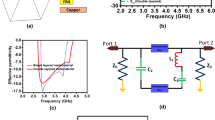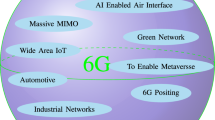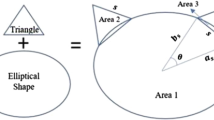Abstract
Chipless radio frequency identification (RFID) is an emerging research area nowadays. The recent development in this area proves its efficiency to compete with low cost identification systems like barcodes in the upcoming years. Chipless RFID encodes data using different kinds of spectral signature produced from some planar images as in the case of barcodes, the difference here is those images are made with conductive materials. Among the different ways of information encoding, a powerful way of encoding is time domain approach. This paper incorporates a tag using group delay encoding. The proposed chipless tag is composed of commensurate cascaded transmission line sections coupled at alternative ends (also known as C-sections). It consists of single group of C-sections. However, in order to increase the coding capacity, the proposed tag can allow multi-frequencies also. In addition to this, the tag is also compatible with commercial ultra wide band radar. The proposed tag is validated experimentally. It exhibits a good reading range of 1.2 m.













Similar content being viewed by others
References
Subramanian V, Frechet JMJ, Chang PC, Huang DC, Lee JB, Molesa SE, Murphy AR, Redinger DR, Volkman SK (2005) Progress toward development of all-printed RFID tags: materials, processes, and devices. Proc IEEE 93(7):1330–1338
Finkenzeller K (2010) ‘RFID Handbook: fundamentals and applications in contactless smart cards, radio frequency identification and near-field communication’ Wiley
Xiao, Y., Yu, S., Wu, K., Ni, Q., Janecek, C., and Nordstad, J.: ‘Radio frequency identification: technologies, applications, and research issues’, Wireless Communication and Mobile Computing, Wiley InterScience, vol. 7, pp. 457–472, (2005)
Vena A, Perret E, Tedjini S (2012) Design of compact and auto compensated single layer chipless RFID tag. IEEE Trans Microw Theory Tech 60(9):2913–2924
Preradovic, S., Balbin, I., Karmakar, N.C., and Swiegers, G.F.: ‘Multiresonator-based chipless RFID system for low-cost item tracking’, Microwave Theory and Techniques, IEEE Transactions on, vol. 57, No 5, pp. 1411–1419, (2009).
Jang HS, Lim WG, Oh KS, Moon SM, Yu JW (2010) Design of low-cost chipless system using printable chipless tag with electromagnetic code. IEEE Microw Wirel Components Lett 20(11):640–642
Vena A, Perret E, Tedjini S (2011) Chipless RFID tag using hybrid coding technique. IEEE Trans Microw Theory Tech 59(12):3356–3364
Tedjini S, Perret E, Vena A and Kaddour D (2012) ‘Mastering the electromagnetic signature of chipless RFId system’, ‘Chipless and Conventional Radio Frequency Identification: Systems for Ubiquitous Tagging’ IGI global
Mukherjee S and Chakraborty G (2009) ‘Chipless RFID using stacked multilayer patches’, Proc. of IEEE International Conference on Applied Electromagnetics (December, 2009), pp. 1–4
Ramos A, Lazaro A, Girbau D, Villarino R (2011) Time domain measurement of time-coded UWB chipless RFID tags. Prog Electromagn Res 116:313–331
Novelda Nanoscale Impulse Radar (2013 January) [Online] Available : https://www.novelda.no/
Hartmann CS (2002) ‘A global SAW ID tag with large data capacity’, Proc. of IEEE Ultrasonic Symposium (October, 2002), pp. 65–69
Zheng L, Rodriguez S, Zhang L, Shao B and Zheng LR (2008) ‘Design and implementation of a fully reconfigurable chipless RFID tag using Inkjet printing technology’, IEEE International symposium on Circuits and Systems( May 2008), pp 1524–1527
Zhang L, Rodriguez S, Tenhunen H and Zheng L.-R (2006) ‘An innovative fully printable RFID technology based on high speed time-domain reflections’. Proc. High Density Microsystem Design and Packaging and Component Failure Analysis 2006 (HDPapos 06) pp. pp. 166–170, (27–28 June 2006)
Schuler M, Mandel C, Maasch M, Giere A and Jakoby R (2009) ‘Phase modulation scheme for chipless RFID-and wireless sensor tags’, Asia-Pacific Microwave Conference (May 2009), pp 229–232
Hu S, Zhou Y, Law C, Dou W (2010) Study of a uniplanar monopole antenna for passive chipless UWB-RFID localization system. IEEE Trans Antennas Propag 58(2):271–278
Lazaro A, Ramos A, Girbau D, Villarino R (2011) Chipless UWB RFID tag detection using continuous wavelet transform. IEEE Antennas Wirel Propag Lett 10:520–523
Chamarti A, Varahramyan K (2006) Transmission delay line based ID generation circuit for RFID applications. IEEE Microw Wirel Components Lett 16(11):588–590
Shrestha S, Balachandran M, Agarwal M, Phoha VV, Varahramyan K (2009) A chipless RFID sensor system for cyber centric monitoring applications. IEEE Trans Microw Theory Tech 57(5):2303–1309
Mandel C, Schussler M, Maasch M and Jakoby R (2009) ‘A novel passive phase modulator based on LH delay lines for chipless microwave RFID applications’,IEEE MTT-S International Microwave workshop on Wirless Sensing, pp 1–4
Gupta S, Nikfal B, Caloz C (2011) Chipless RFID system based on group delay engineered dispersive delay structures. Antennas Wirel Propag Lett, IEEE 10:1366–1368
Nair RS, Perret E, Tedjini S (2013) A temporal multi-frequency encoding technique for chipless RFID based on C-sections. Prog Electromagn Res B 49:107–127
Settaluri RK, Weisshaar A, Lim C, Tripathi V (1999) Compact multi-level folded coupled line RF couplers. IEEE Trans Microw Theory Tech 47(12):2331–2339
Lam HJ, Lu Y, Du H, Poman PM, Bornemann J (2008) Time-domain modeling of group-delay and amplitude characteristics in ultra wide band printed circuit antennas. Springer Proc Phys 121:321–331
Ling R, Ufimtsev P (2001) Scattering of electromagnetic waves by a metallic object partially immersed in a semi-infinite dielectric medium. IEEE Trans Antennas Propag 49(2):223–233
Vena A, Perret E and Tedjini S (2012) ‘High capacity chipless RFID tag insensitive to the polarization’, IEEE Transactions on Antennas and Propagation, vol 60, No 10
Nair, R., Perret, E., Tedjini, S. and Barron, T. : “A humidity sensor for passive chipless RFID applications”, IEEE International conference on RFID-Technologies and Applications(RFID-TA), Nice, France, November 5–7, (2012)
Author information
Authors and Affiliations
Corresponding author
Additional information
This work is financially supported by the French National Research Agency via ANR-09-VERS-013 program
Rights and permissions
About this article
Cite this article
Nair, R.S., Perret, E. & Tedjini, S. Group delay modulation for pulse position coding based on periodically coupled C-sections. Ann. Telecommun. 68, 447–457 (2013). https://doi.org/10.1007/s12243-013-0370-y
Received:
Accepted:
Published:
Issue Date:
DOI: https://doi.org/10.1007/s12243-013-0370-y




